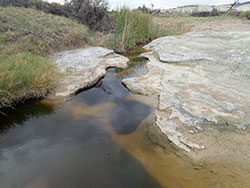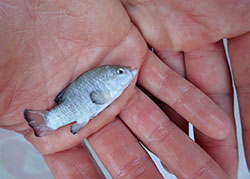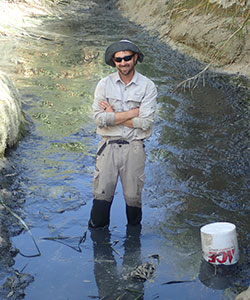
Shoshone pupfish habitat in the Amargosa River.

Shoshone pupfish from the Amargosa River.

Nick in the Amargosa River following green sunfish removal.
CDFW environmental scientist Nick Buckmaster works as a biologist in the Heritage and Wild Trout program. Based in Bishop (in the northern part of Inyo County), he’s far from where he grew up in San Diego County, but he couldn’t be closer to what he loves: California’s natural resources.
As a member of the team managing heritage and wild trout, Nick helps protect and restore native trout and habitats through field studies and data analysis. He initially joined CDFW six years ago to work in habitat conservation, moving over to his current assignment about a year ago. He’s a graduate of UC Davis with Bachelor’s degrees in Wildlife Fisheries Conservation and Geology. His Master’s degree is in Ecology.
Tell us about your current assignment – what to you do?
I’m the heritage and wild trout biologist for Inyo and Mono counties; which is really about managing the Eastern Sierra fisheries in a sustainable fashion. Rather than relying on stocking, we work to manage the populations to ensure good fishing into the future. That allows me to work on two different threatened trout species that occur out here – Lahontan cutthroat trout and Paiute cutthroat trout – as well as manage some of the most iconic trout fisheries anywhere in California, if not the United States. On a day-to-day basis, I could be anywhere from 11,000 feet up in the High Sierra, to the desert streams of the Owens River Valley. It’s a pretty sweet setup. When I got the job offer to come out here, I didn’t think twice. I packed up and lived out of my car for a couple of weeks, until I found a place to rent.
So you’re checking on the health of a fish in a particular body of water to make sure it’s doing well, and that tells you other fish in that area are doing well?
Fisheries monitoring can include a number of things. A lot of it can be quick reconnaissance assessments -- looking at population structure and relative weight of the fish. From there you can drill down into habitat specifics and stream production. What’s the stream temperature, are your pools deep enough, is there enough food for the fish to grow, are they growing fast enough, are they reaching the size we want? Are there other potential stressors, like drought, flood or upstream water diversions?
How did you come to decide on ecology – and fisheries, specifically – as a profession?
I grew up in a small town (Descanso) playing in the mountains and hills every day, hunting and fishing. When I took biology in high school, there was a brief section on ecology, where we talked about lakes and how the various fisheries are supported, and I was a huge fisherman when I was younger, and it just clicked. All of a sudden, fishing became a science for me. Science was something I was already passionate about. I always loved the outdoors, ecology and nature.
How do you balance the need to preserve our resources in their natural state, and the idea that we can or should take action to assist species?
One of the things I did previously out there was work a lot with pupfish in lower elevation areas. Those are species that only persist because of human intervention. The Owens pupfish was rescued by a fish and game biologist from extinction in 1969 – if he hadn’t put them in a bucket, they would have blanked out. At the end of the day, conservation always requires some measure of management.
In 1910, humans brought largemouth bass into the Owens Basin. That drove the Owens pupfish to the brink of extinction. If humans hadn’t also stepped in and removed the bass, the Owens pupfish would have been wiped out. There was a similar situation with cutthroat trout in the Walker Basin (Kern County), where a lot of the habitat had been impacted by logging in the late 1920s. The habitat still hasn’t recovered, so it’s up to us as a management agency to go in and try to take that ecosystem-based approach to restore the stream and the fishery.
Almost every habitat I’ve encountered out here has been so profoundly impacted by humans … it’s not necessarily a question of whether to intervene, but how to intervene in the most appropriate way.
Is there a particular project you’ve worked on in which you saw the results and realized you made a difference?
Last August we had green sunfish invade the Shoshone Springs on the other side of Death Valley. Springs in the desert are a lot like islands in the ocean. They’re the only habitats like them for tens or hundreds of miles. In this case, Shoshone Springs has an endemic pupfish called the Shoshone pupfish. All pupfish, at least in the desert southwest, are highly susceptible to non-native predation. These non-native predators can eliminate a pupfish population in less than six months in some cases. So in early August, we had the non-native green sunfish show up in the only known habitat for Shoshone pupfish. They had washed down from Crystal Reservoir in Nevada during a heavy rain season – typically it’s a dry riverbed. Another employee and I went out and worked in 110 degree weather, for two weeks, to remove the sunfish from the pupfish habitat. Within the course of just two weeks, we removed what can only be described as an existential threat to the Shoshone pupfish. Those efforts secured the species going forward. At the end, I don’t think I’ve ever felt more satisfied with my job.
If you had an unlimited budget and unlimited time, what project would you like to tackle?
I’d probably try to restore cutthroat trout in the Walker Basin. It’s one of the most distinct cutthroat trout on the face of the planet. They’ve been in that basin for millions of years. They’re very rare at this time, but if left to their own devices they get really large. They’re fantastic fish to catch – they’re just beautiful. I would probably put them back. We all love catching big cutthroat trout at Pyramid Lake (Nevada), and I’d like to see that in Eastern Sierra. A project like that would fit with my passions of conservation, native fish management and recreation.
Can you describe a typical day of work?
Today I’m working from home on a couple of reports involving analysis of fish population data. On a field day, I would be hiking into the high country or back country to conduct some level of fisheries assessment. Office days involve typical tasks like answering emails, data analysis or writing summary reports. To be honest, I really like the balance that I have. While it’s critical to do field work in order to collect the information necessary to make decisions as natural resources agency, it’s also important to answer emails and maintain relationships with the public, co-workers and management. If you collect all the data in the world, and don’t share it, you might as well not have collected it at all.
CDFW Photos